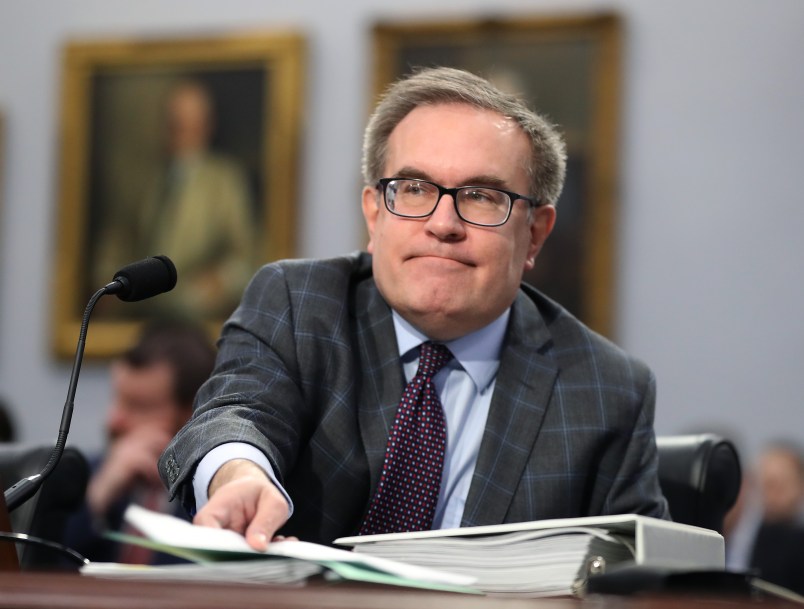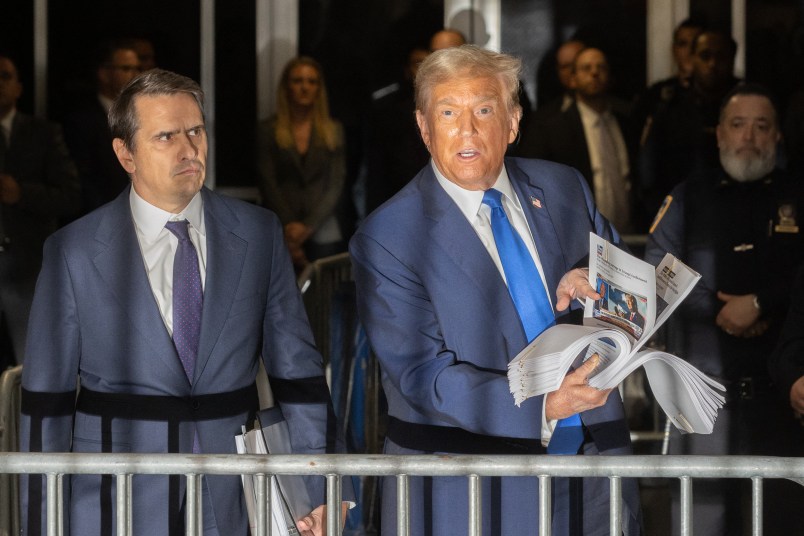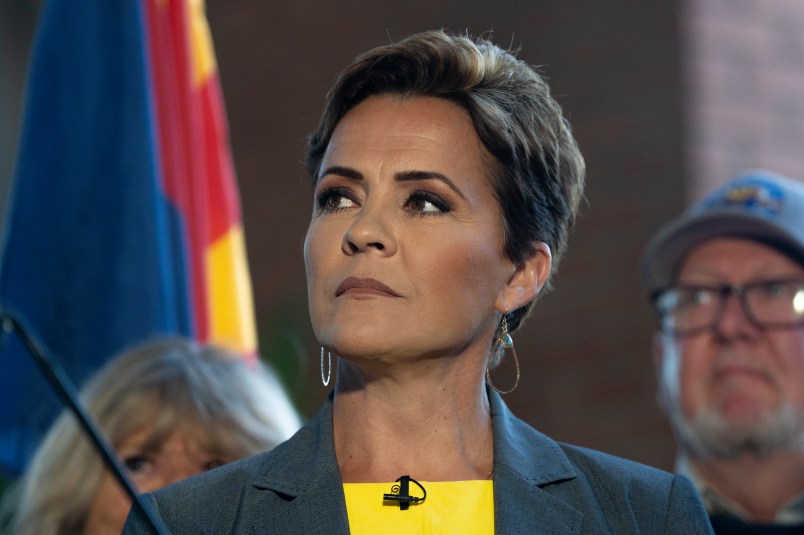 When Scott Pruitt was ousted from the Environmental Protection Agency last summer, environmentalists collectively held their breath as Trump mused over who his replacement nominee might be.
When Scott Pruitt was ousted from the Environmental Protection Agency last summer, environmentalists collectively held their breath as Trump mused over who his replacement nominee might be.
In his previous job as attorney general of Oklahoma, Pruitt had, famously, sued the agency he had gone on to lead more than a dozen times. Though he was almost comically scandal-prone, Pruitt was widely lauded by Trump supporters and limited-government conservatives for his success in rolling back numerous, groundbreaking environmental regulations put into place by the Obama administration. It was an open question whether his successor would be quite so openly opposed to the EPA’s traditional mission.
In January 2019, Trump nominated Andrew Wheeler, who he’d designated as acting head of the agency since Pruitt’s exit. Since his confirmation in February, Wheeler has proven to be every bit as effective as Pruitt — without the accompanied scandal. He’s dismantled numerous regulations on emissions from coal power plants and automobiles and weakened the EPA’s ability to criminally enforce anti-pollution rules. While most environmental policy experts agree that Wheeler’s ideology is no more extreme than Pruitt’s, the new head’s background as a coal lobbyist gives him a level of know how — a suave expertise that Pruitt, with his ethically challenged approach to getting things done, lacked.
“Wheeler is more sophisticated, he has more experience,” UCLA law school professor and co-director of the Emmett Center on Climate Change and the Environment Ann Carlson told TPM Tuesday. While Pruitt’s deregulatory moves were often overshadowed by his ethical challenges, Wheeler has managed to avoid spending extended time in the daily news cycle. But that doesn’t mean he’s had a slow summer.
Based on interviews with experts, we’ve compiled a list of some of the most impactful moves the ex-coal lobbyist has taken on the environment since May.
1. Yes, it’s the lightbulbs giving Trump that orange glow.
In the past few weeks, the Trump administration rolled back Obama-era rules that would have eventually significantly increased the energy efficiency of light bulbs across the board. The administration announced this week that it cut a rule meant to go into effect in January 2020. Had the new rules actually come to fruition, four categories of incandescent and halogen bulbs — those used in chandeliers, track lighting and bathroom fixtures — would have been required to follow the same energy efficiency standards that they’ve previously been exempt from.
The new standards would have affected about half of the six million light bulbs in use and would’ve saved American consumers billions of dollars, as well as prevented millions of tons of carbon dioxide from spilling into the atmosphere, according to the National Resources Defense Council’s Center for Energy Efficiency Standards. The rule was based on legislation passed under the George W. Bush administration, designed to phase out incandescent and halogen light bulbs by 2020.
The Trump administration argued the rule, which was expanded under Obama and based on the legislation passed by Congress in 2007, wasn’t “consistent with the best reading of the statute.” Trump told reporters this week that the actual savings to Americans wasn’t enough to justify allowing the rule to go into effect.
But, for Trump, there was another important factor: “People said ‘what’s with the light bulb?’ I said here’s the story, and I looked at it: The bulb that we’re being forced to use — number one, to me, most importantly, the light’s no good. I always look orange,” he told House Republicans at a retreat last week.
2. Trump changes the definition of the Waters of the United States (WOTUS).
Wheeler announced the rollback of a set of Obama-era Clean Water Act rules just last week. The new Trump administration rule tosses out an Obama plan that expanded which bodies of water in the U.S. were protected by the Clean Water Act’s limits on pollution.
Prompted by lawsuits from as many as 31 states to change the rule, as well as an outcry from the mining, development and farming lobbies, the Trump administration announced in 2017 that the repeal of the 2015 rule would be an EPA priority.
Environmentalists plan to challenge the rule change in court.
3. Trump moves to relax rules on emissions of the most powerful greenhouse gas.
Wheeler announced just last month that the administration would loosen some of the federal rules surrounding the regulation of methane emissions into the atmosphere, allowing oil and gas companies to police themselves on emissions. Methane is the most potent of greenhouse gases — dealing 80 times more damage to the climate, in the short term, than carbon dioxide — and the gas companies are split on whether they supports the measure, which the Trump administration pursued to help increase those exact companies’ profits.
While many natural gas producers have lobbied the Trump administration to lift the regulations, other energy giants like BP have publicly opposed it.
4. Wheeler replaced Obama’s signature climate change policy with a weaker plan.
While the 2007 Supreme Court ruling in Massachusetts v. EPA holds that the Environmental Protection Agency must legally regulate greenhouse gas emissions, the Trump administration has done everything it can to limit how robustly it will do so.
In June, Wheeler announced that President Obama’s Clean Power Plan would be replaced with a much weaker alternative: the Affordable Clean Energy rule. Under the Obama-era rule, the power sector was charged with reducing its greenhouse emissions 32 percent than what it was in 2005 by the year 2030. Under the new rule, emissions only have to be reduced by between .7 and 1.5 percent in the same time frame.
As some climate researchers have noted, the new rule could actually increase the amount of greenhouse gas emissions coming from the U.S. Under the new rule, researchers predict that greenhouse gas emissions will increase in 18 states and Washington, D.C., due to a phenomenon that the Harvard School of Public health defines as an “emissions rebound.”
“The key takeaway is that ACE is a free pass for carbon emissions. The agency’s proposal could cause some coal plants to run longer, generating more pollution that drives climate change and harms human health,” Kathleen Lambert, the senior adviser at the Center for Climate, Health and the Global Environment at Harvard’s public health school, said in a study on the impacts of the rule change.
Because of the “rebound,” the rule change could also lead to thousands more deaths due to air pollution — something the EPA itself admits.
5. What oil spill?
In May, the Trump administration pared back some of the safety measures that were put in place in 2010 to regulate offshore drilling following the massively catastrophic explosion at a BP oil well in the Gulf of Mexico. The explosion killed 11 people and spilled over 200 million gallons of oil into the ocean.
Following the spill, the Obama administration attempted to curb the likelihood of a repeat blast by requiring more tests on the mechanisms that prevent blowouts on the drilling rigs and implemented safety checks by independent investigators.
The Trump administration essentially reversed these rules in May.
…but the most dangerous is yet to come.
As fall approaches, the Trump administration will soon enact one final rule that, Carlson says, could be the most dangerous of the summer: cutting car emission standards across the U.S., while simultaneously revoking the state of California’s right to set its own greenhouse gas emission standards. News broke Tuesday that the new California regulation would be announced Wednesday.
The new nation-wide rule would not only freeze emission requirements for new cars and trucks until 2026, it would also reduce the fuel efficiency rules put in place by the Obama administration.
The move will likely be challenged by the state of California and environmental groups in court. Carlson said the decision was at the “top” of her list of the most dangerous moves the Trump administration has made in recent months.
“Transportation emissions are now the greatest source of greenhouse gas emissions in the United States and unlike emissions from the electric power sector, they’ve been on the increase, not on the decline,” she said.
“Electric power sector emissions are going down because of advances in renewable technology, replacement of coal and natural gas — a bunch of reasons,” she explained.
But relatively low gas prices and a strong economy means gas consumption is on the rise as consumers buy more and purchase larger cars. “The last thing we should be doing is freezing car standards,” Carlson said.
Environmental advocates see a sign of hope: if Trump is not elected in 2020, many of these rollbacks may not be enacted.
As Carlson noted to TPM, many of the most dangerous rollbacks we saw this summer will take years to actually go into effect, further elevating the implications of the 2020 presidential primaries and general election.
“They’re quite reversible,” Carlson said.
“Take the auto standards. Even if they issue a rule today, the auto industry needs enough lead time for its manufacturing process. It’s already going to use the current standards for, say, 2021 models and maybe into 2022. The Clean Power Plant wasn’t even suppose to go into effect until the next decade.”
Even if the EPA does an about face under a future president, however, there will be lasting damage, Carlson said. “We could limit the damage on the rule rollbacks, but what they’ve done to decimate the morale of the agency, losing personnel and so forth is really really troubling.”
This story is part of Covering Climate Now, a global collaboration of more than 250 news outlets to strengthen coverage of the climate story.










